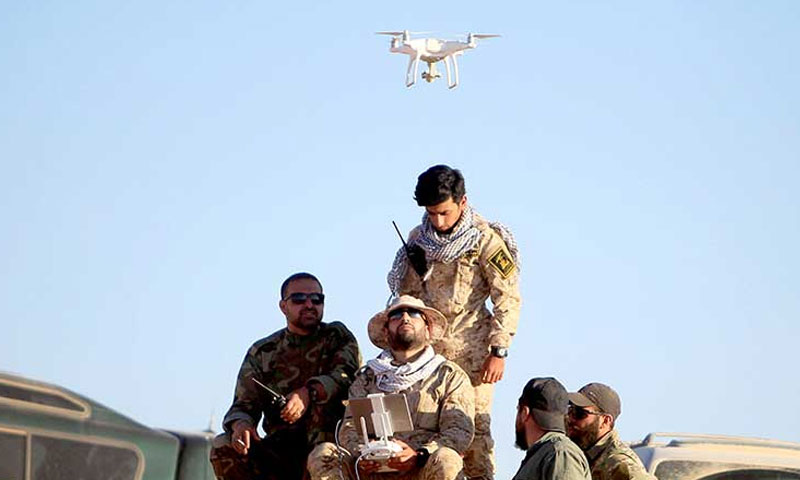The absence of the military aircraft failed to give Southern Syria’s sky its clarity again, for it is thriving with reconnaissance aircraft, of many types and various missions, and most importantly from different national backgrounds, turning the sky into a stage for a competition to spot targets, collect data and terrify congregations.
In the six months that followed the implementation of the “de-escalation” agreement in southern Syria, in July 2017, the Syrian regime’s military aircraft and helicopters departed the sky above Daraa and Quneitra governorates, throughout a period, considered as the longest since the military aircraft were used in the history of the revolution, which positively reflected on the humanitarian conditions in the area, despite the repetitive violations by resorting to artillery shelling every now and then.
The Sky Has its Own Distinct Borders
Despite the division of the field map in Daraa and Quneitra between three parties: the Assad’s forces, the opposition factions and the “Khalid ibn al-Walid Army,” faction, accused of affiliation to the “Islamic State” ISIS, the distribution of the land did not affect the sky of the two governorates, for it has been taken over by reconnaissance aircraft that belong to the regime or to the opposition factions, in addition to Israeli, Russian, Iranian and Jordanian ones.
Currently, the opposition’s Observatory Centers, assigned to monitor the movement of the aircraft in southern Syria, are focusing on warning the people upon spotting any reconnaissance aircraft, “fearing that they might be photographing congregations to target them with artillery shelling,” according to Rami al-Homsi, an activist functioning in an aircraft’s observatory center, saying that “we cannot spot all types of aircraft, especially the small ones, which Assad’s forces use at the military fronts and for short distances.”
Bothe the opposition factions and Assad’s forces, in addition to a number of media outlets, depend on “phantom” airplanes, which prices vary between three to five thousand American dollars.
The efficiency of these airplanes is limited if compared to the military reconnaissance aircraft, which the observatory centers can easily spot, “due to their size, slow movement and sound which can be heard clearly,” according to the activist, who pointed out that “the observatory centers most likely believe that these aircraft are launched from different places.”
He told Enabb Baladi that the aircraft which come from Damascus’ direction are heading to the Death Triangle and Quneitra governorate, where “Hezbollah” members are spread, are of an Iranian origin. As for the aircraft launched from the “Brigade 34,” they are Syrian.
The border line with occupied Golan is the major stage for the competition between the Iranian and Israeli aircraft, that seem to be unable to dispense with its sky, according to the activist, who added that the area of the Yarmouk Basin, which “Khalid ibn al-Walid Army,” controls is witnessing an intensified areal movement by the Israeli reconnaissance aircraft, within the borders and deep into the areas under the Jihadist Faction.
Is It a Friend or an Enemy?
Similar, every now and then, the southern area witnesses a movement by the Russian reconnaissance aircraft, which the observatory centers can easily detect due to their modern construction.
According to al-Homsi, the Russian aircraft fly above the International Highway to accompany some of the Russian Officials when they come to Daraa governorate; on other times, they fly over the line separating the administrative borders of Daraa and As-Suwayda governorates.
The Jordanian reconnaissance aircraft have repeatedly, in the past six months, entered the Syrian sky, which major target, according to the activist, is monitoring any military movement on the part of the pro-regime Shiite militias in the southern area.
Military sources told Enab Baladi, in November 2017, that the Assad’s forces have tried to down one of the Jordanian reconnaissance aircraft which entered Dara governorate’s sky, but they failed to do so.
An Iranian reconnaissance aircraft, downed by Israel after it entered the occupied Golan’s sky, was about to entice a regional war, on last March 10, during a time, where reconnaissance aircraft became a crucial part of the battle and the importance of downing them does not differ from that of hitting a military aircraft.
When the sky of Southern Syria became jammed with “multinational” aircraft, the different parties in control on the land, are now supposed to look at the sky more, think deeply and wonder before firing, is it an enemy or a friend aircraft?

